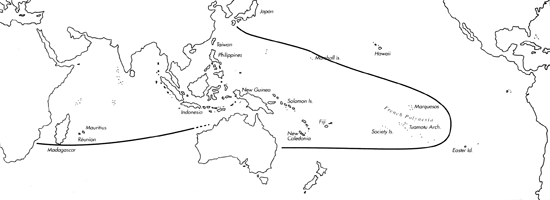
Skip Navigation Links
View access keys for this site.

Range: Entire Indo-Pacific, except for Hawaii.
Description: Moderately large to large, solid to heavy. Last whorl conical; outline slightly convex at adapical fourth, straight below. Shoulder angulate. Spire low, outline slightly concave to slightly convex. Teleoconch sutural ramps almost flat to slightly concave; late ramps with 3 increasing to 5-6 spiral grooves, either paralleled by additional striae or replaced by numerous striae in latest whorls. Last whorl with weak to obsolete spiral ribs near base; widely spaced fine ribs and wrinkled threads between may extend to centre or beyond.
| Shell Morphometry | ||
|---|---|---|
| L | 55-151 mm | |
| RW | 0.50-1.34 | |
| (L 55-134 mm) | ||
| RD | 0.54-0.61 | |
| PMD | 0.86-0.92 | |
| RSH | 0.03-0.10 | |
Colour white to yellow or orange; occasionally with darker orange collabral lines marking growth cessations (Pl. 31, Fig. 2). Base dark blue-violet. Larval whorls bright purple (eroded in adults). Aperture white, blue-violet at base.
Periostracum greenish brown to brown, thick, opaque, horny or with fine axial ridges
Dorsum of foot white mottled with brown, with a cross-shaped, black transverse blotch on anterior part, a black blotch at opercular area, and a dotted brown pre-marginal line between; posterior end and anterior comers white; sometimes 4 short longitudinal rows of black dots on anterior central part. Edge of foot yellow to orange, sometimes continuing onto dorsum. Sole of foot cream mottled with brown, sometimes darker brown anteriorly. Rostrum and tentacles yellow or yellow dorsally and white ventrally. Garrett (1878) reports a black transverse band on the rostrum. Siphon whte edged with yellow, with a black transverse band 113 the length from the tip and a brown band or dorsal group of brown dots at base (Pl. 76, Fig. 46; Pl. 80, Fourth row, right) (Chaberman, pers. comm., 1981; Kohn, unpubl. observ.; Pearson unpubl. observ.; Fainzilber et al., 1992).
Radular teeth long and curved, with 2 opposite adapical barbs; serration extends more than halfway down the shaft, terminating in a backward-pointing cusp; base with a distinct spur (Bergh, 1895; Peile, 1939; Bandel, 1984; Kohn, unpubl. observ.)
Habitat and Habits: In 0.5- 15 m; in sand and rubble on reef flats, sometimes amongst weed and beneath dead coral rocks. C. virgo feeds on terebellid and other polychaetes (Kohn, 1960; Kohn & Nybakken, 1975; Tirard, pers. comm., 1989; Grosch, pers. comm., 1989; Fainzilber et al., 1992). C. virgo aggregates for mating and spawning. Egg capsules affixed in short rows to the underside of coral rocks by confluent basal plates, forming an irregular dense cluster. Oviposition observed in November, January and August, near the seaward edge of the reef in about 1.5 m of water Sri Lanka and Seychelles; Kohn, 1961b). Capsules of varying outline and size, between 12-13 x 12-13 mm and 30-32 x 20-22 mm at the same locality. Number of eggs per capsule is 3,900-18,000, that of eggs per spawn mass 58,000-700,000. Egg diameter of 170-225 ┬Ám suggests a minimum pelagic period of 26-21 days (Kohn, 1961b; Perron & Kohn, 1985).
Discussion: For the distinction of C. virgo from the similar species C. emaciatus, C. terebra, and C. coelinae, see the Discussions of those species.

C. virgo range map
This section contains verbatim reproductions of the accounts of 316 species of Conus from the Indo-Pacific region, from Manual of the Living Conidae, by R÷ckel, Korn and Kohn (1995). They are reproduced with the kind permission of the present publisher, Conchbooks.
All plates and figures referred to in the text are also in R÷ckel, Korn & Kohn, 1995. Manual of the Living Conidae Vol. 1: Indo-Pacific Region.
The range maps have been modified so that each species account has it own map, rather than one map that showed the ranges of several species in the original work. This was necessary because each species account is on a separate page on the website and not confined to the order of accounts in the book.
Return to framed version (returns to search page)